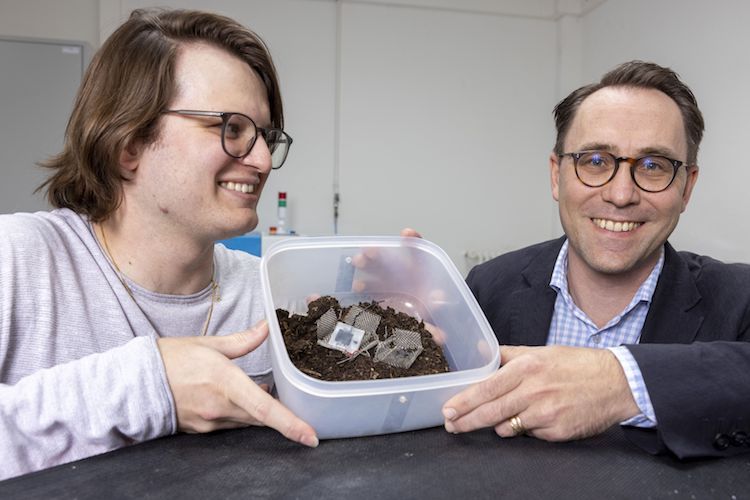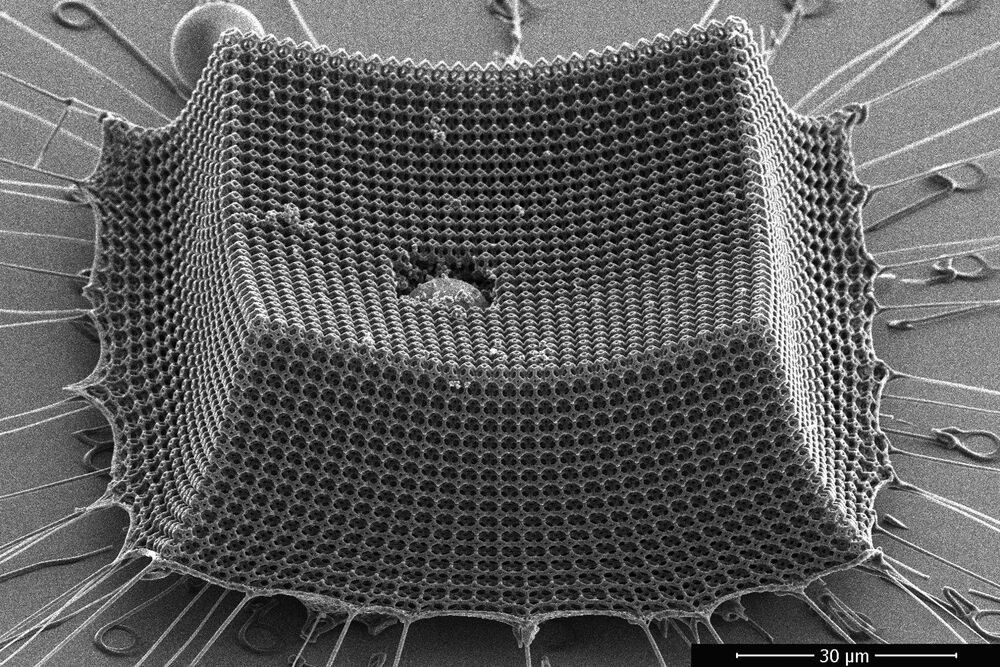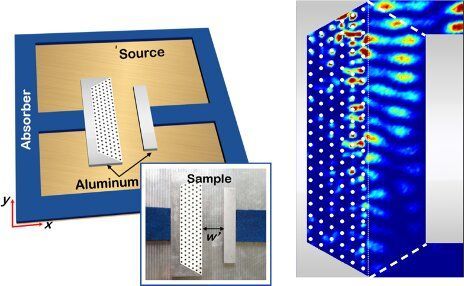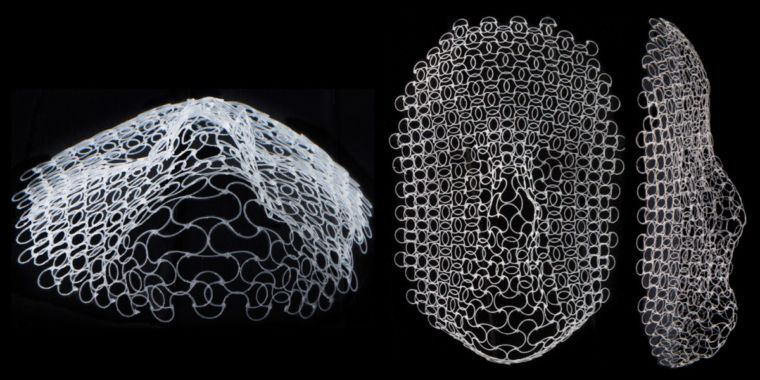3D-printed devices made from a biodegradable paper-like material could power the Internet of Things in a more sustainable way.
Category: materials – Page 204
The new carbon-based material could be a basis for lighter, tougher alternatives to Kevlar and steel.
A new study by engineers at MIT, Caltech, and ETH Zürich shows that “nanoarchitected” materials — materials designed from precisely patterned nanoscale structures — may be a promising route to lightweight armor, protective coatings, blast shields, and other impact-resistant materials.
The researchers have fabricated an ultralight material made from nanometer-scale carbon struts that give the material toughness and mechanical robustness. The team tested the material’s resilience by shooting it with microparticles at supersonic speeds, and found that the material, which is thinner than the width of a human hair, prevented the miniature projectiles from tearing through it.
High dark current can significantly impair the performance of infrared photodetectors, devices that can detect photons in the form of infrared radiation. For many years, most solutions for blocking dark current used the electric field inside the detectors.
Researchers at the Chinese Academy of Sciences recently devised an alternative solution to suppress dark current in photodetectors, which is based on the use of van der Waals (vdW) heterostructures. In a paper published in Nature Electronics, they presented visible and mid-wavelength infrared unipolar barrier photodetectors made of band-engineered vdW heterostructures.
“Since Bell Labs produced the Si-based PN junction in 1935, using the built-in electric field in the depletion region has become the main technical route to block dark current,” Weida Hu and Peng Zhou, two of the researchers who carried out the study, told Tech Xplore via email. “In traditional PN junctional infrared photodetectors, the high Shockley-read-Hall (SRH) recombination and surface recombination in the depletion region seriously limit the suppression of dark current. In response to these issues, engineers introduced a new device structure beyond the PN junction, namely the unipolar barrier structure.”
Researchers from Baidu Research and the University of Maryland have developed a robotic excavator system that integrates perception, planning, and control capabilities to enable material loading over a long duration with no human intervention.
Ordinarily, if you’re building something, you don’t want the materials to buckle under pressure. In a new Harvard University-designed system, however, that buckling action allows flat-packed objects to be twisted into useful three-dimensional forms.
Most existing “buckling-induced deployable structures” consist of linked straight pieces that are popped into shape via straight linear motion, which often requires a fair bit of force to be applied by the user. Folding chairs are one frequently frustrating example.
Seeking an easier alternative, Harvard researchers instead set about building items made up of linked curved pieces. Generally speaking, curved objects (such as beams) are less mechanically stable than their straight counterparts. In most scenarios, this is an undesirable quality. In the case of pop-up devices, though, it means that they’re easier to buckle into the desired form.
Entering an invisible doorway to catch a train at King’s Cross station in London is a renowned fictional scene from the Harry Potter series. In recent decades, physicists have been trying to produce a similar effect by focusing their research efforts on illusion devices.
Illusion devices are devices that can change the optical properties of objects to match those of other virtual objects or make them apparently invisible, producing an illusion. Two common types of illusion devices are super-scatterers and invisible gateways. The first are designed to scatter light and the second to bounce back light rays through a physical gateway.
From a theoretical standpoint, super-scatterers and invisible gateways have so far been primarily studied in the context of transformation optics and folded geometry transformations (i.e., the visual, illusory transformation of objects into other objects). Experimentally realizing these devices, however, requires the use of metamaterials with specific properties (e.g., a negative permittivity and permeability) that can be difficult to employ in fabrication processes.
Astronomers Pedro Bernardinelli and Gary Bernstein discovered a space object recently that has an orbit around the sun and also stretches into the Oort cloud—they have named it 2014 UN271. The researchers made the discovery while studying archival images collected for the Dark Energy Survey over the years 2014 to 2018. Since its discovery, entities such as the MMPL forum, the Minor Planet Center and JPL Solar System Dynamics have been tracking the object and have found that it will make its closest approach to Earth in 2031.
Measurements of the object put it between the size of a very small planet and a comet—it is believed to have a diameter of 100 to 370 km. If it turns out to be on the larger end of that spectrum, it would mark the largest Oort cloud object discovered to date. But it is the path of the object that has drawn the attention of astronomers—its orbit is nearly perpendicular to the plane created by the nine inner planets and takes it deep into the solar system and into the Oort cloud. One trip around the sun has been calculated to take 612190 years. It is currently moving deeper into the solar system, which means astronomers will have an opportunity to observe it 10 years from now.
Sam Deen, an amateur astronomer posting on the MMPL forum described the find as “radically exceptional.” Study of 2014 UN271 as it draws closer will allow researchers to analyze an object that sometimes passes through the Oort cloud at distances as close as 10.9 AU from the sun—near the orbit of Saturn. As it draws nearer to the sun, it is likely to develop a comet-like tail as frozen material on its surface is vaporized. It is not clear just yet, however, how bright 2014 UN271 will appear in the night sky here on Earth—but it is likely that its brightness will fall somewhere between that of Pluto or its moon Charon; enough for amateurs and professionals alike to get a good view of it using strong telescopes.
I like this one, especially because using recycled materials has no loss in efficacy.
Beating the heat with paper.
Apollo Project for Water
Posted in materials, sustainability
With the drought in the west it is time to consider an Apollo Program to produce clean water. Breakthroughs in processing lithium and with graphene-based desalination membranes may point the way. (Meant to say almost 20 Million people — needed some coffee tonight!)
See the Special Deals at My Patriot Supply: www.PrepWithGreg.com.
Green Gregs has teamed up with True Leaf Market to bring you a great selection of seed for your spring planting. Check it out: http://www.pntrac.com/t/TUJGRklGSkJGTU1IS0hCRkpIRk1K
See my sister channel Galactic Gregs: https://www.youtube.com/channel/UCmigPwwtQbetT7aVa9ToRuA
Support freedom: FreedomRestorationFoundation.org.
To join the Freedom Restoration Foundation (FRF) email: info@ FreedomRestorationFoundation.org.









